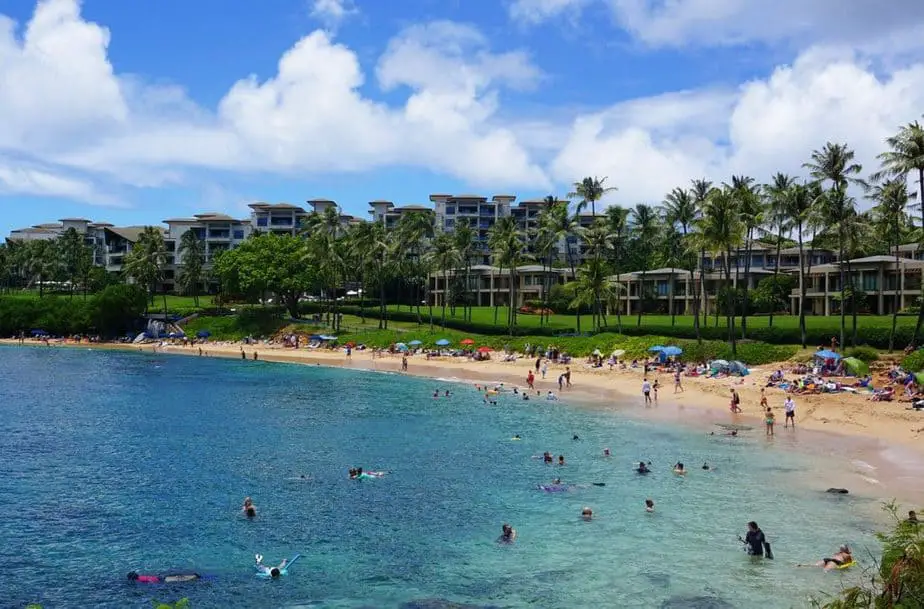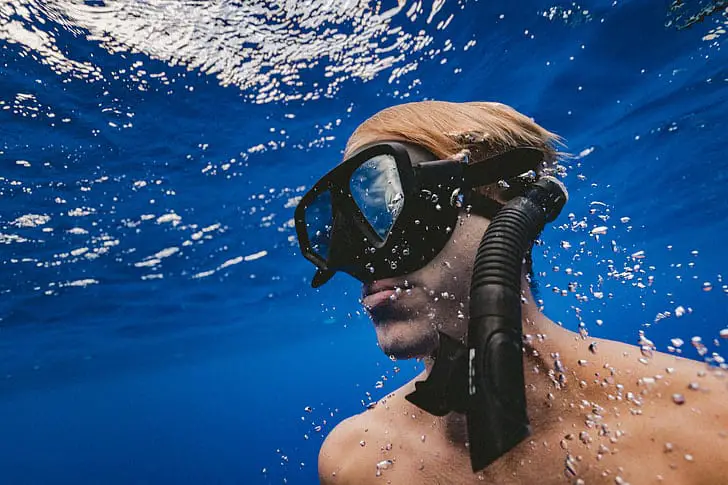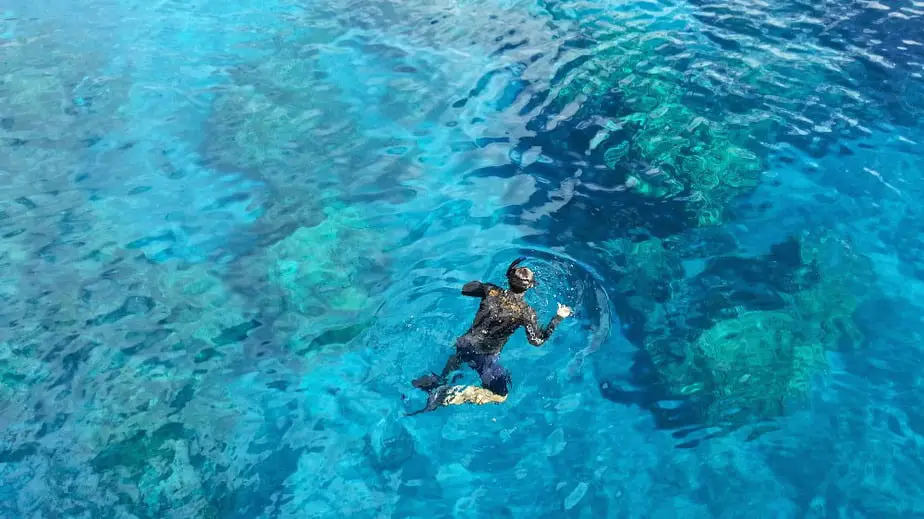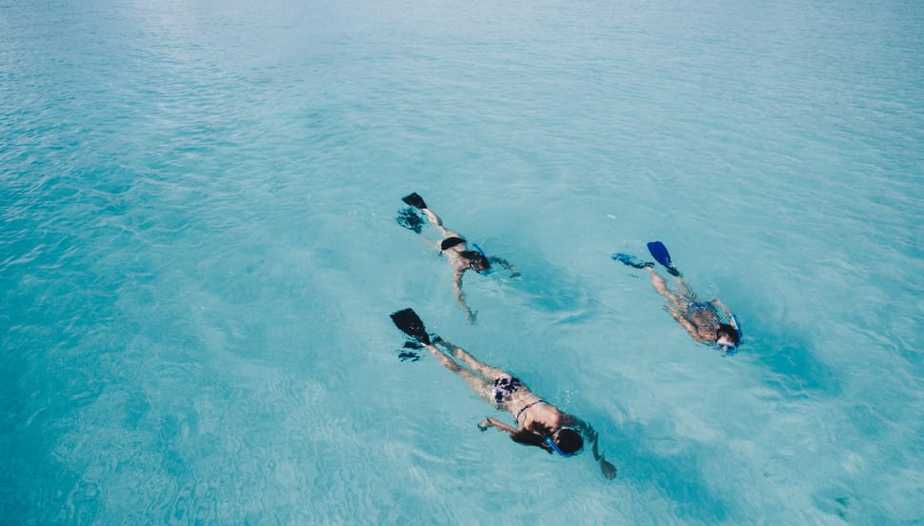At its core, snorkeling is not a very difficult hobby. The barrier for entry is very low, which is why thousands of people worldwide, even young children and entire families have the luxury to enjoy it. However, the devil is in the details, and there are some advanced snorkeling tips that beginners and even seasoned snorkelers may not know about.
These tips can help be the difference between a good snorkeling trip and an excellent one. Furthermore, if you have some physical or medical conditions that are holding you back from enjoying snorkeling, then perhaps some of these tips can help you. Furthermore, the advanced snorkeling tips covered in this article is something you should keep in mind in case one day it ever applies to you, a friend, a family member, or even a stranger that doesn’t know any better.
1. Packing Snorkeling Gear Efficiently for Travel
Starting off on our list is a relatively simple tip that not everyone does very well.
Knowing how to efficiently pack your belongings for a trip is an essential skill if you plan on traveling a lot. Thankfully snorkeling doesn’t require much gear (only the mask and snorkel are essential), but if you want a better experience you may want to bring some fins and a rash guard. Here are still some tips to keep in mind in order to save as much space as possible when traveling.
First, try to find travel or smaller versions of the standard snorkeling gear. For instance, you can buy short fins for travel or folding fins that can fit in a carry-on, though they will be more expensive. For masks and snorkels, there isn’t much you can do to save space except for getting a low-volume mask and a shorter snorkel. Full face masks can be more of a space hog, so be wary of that.
Depending on how long you plan on traveling, try to limit the amount of clothing you bring. Clothes can be easily replaced, however it will be a lot harder to replace nice fins or a custom fit mask in remote locations.
When packing your fins if you find that they are sticking out of the bag due to their length, try to fit them in diagonally. Then layer your other belongings around it, packing in every odd space.
Hopefully you aren’t planning on snorkeling in cold water, because a full 3mm+ wetsuit would occupy a lot of room in your luggage. Instead, look for thin dive skins or full rash guards as thinner alternatives for full-body protection. These can be much more easily folded up and packed into tight spaces.
Many travelers recommend using a gym bag style carry-on to accommodate their snorkeling gear. First, due to its length, it allows you to fit in fins without folding them or putting them in diagonally. Second, they can fit lengthwise into overhead bins on the plane. They also have more room than a duffel bag or backpack. Furthermore, they don’t need to be checked in so you won’t have to wait around for luggage, just bring it on the plane with you.
2. Dealing with Water Distortions
Sometimes when you are snorkeling, you may notice some peculiar distortions in the water. It looks reminiscent of heat hazes in the desert or wavy lines in the water. Don’t worry, this is a natural phenomenon and is not your brain playing tricks on you, nor is it anything to be concerned about.
There are two possible reasons. The first is when there is saltwater and freshwater in close proximity that have not yet mixed together. Due to the different densities of the water, you may notice the distortion and this is referred to as a halocline. This can happen when there’s a source of freshwater nearby or if it rained recently.
The second reason is when there are sections of water at different temperatures in close proximity that have not mixed together, and this is known as a thermocline. The low visibility caused by haloclines and thermoclines led to a lot of panic in some snorkelers, who believed they were suffering from a health issue that impaired their vision.
To address this, simply swim around and mix the water to improve your visibility.
3. Snorkeling in Cloudy Weather
You might be wondering if it is a good idea to snorkel when it is cloudy outside. How does having reduced sunlight affect your snorkeling experience? Opinions are mixed, as many believe that the muted colors and lower visibility detract from the experience. On the other hand, some snorkelers believe that the lack of shadows means that more sea life (e.g. eels, fish, manta rays) are willing to remain in the open for longer, allowing you to spot them and maybe even swim with them.
However, most snorkelers agree that they would not cancel a trip just because the sun isn’t out. With that said, having overcast weather is a cause for concern if it is a precursor to heavy winds and rain. Furthermore, just because the sun isn’t out doesn’t mean you don’t need sun protection. After all, UV rays can penetrate clouds and still damage your skin, so continue using sun protection even on cloudy days.

4. Using Weather Forecasts to Select a Snorkeling Spot
If you want to have more control over the conditions in which you will be snorkeling in, you should check out weather forecasts to help you plan your snorkeling day. Specifically, the wind direction and speed can drastically affect your snorkeling experience. Websites like Windfinder or Windguru, though they are geared towards kite and wind surfers that prefer to have strong winds, can be extremely helpful for helping you avoid them.
In the US, you can browse the National Weather Service website to see if there are any data about nearby locations that can help you. Once again, look for any news about the wind, and go to the locations with mild to no wind.
Another consideration if you are looking for calm snorkeling locations is keeping an eye out for swell, or ocean waves. Swells are generally caused by weather systems nearby. You can find information about swells on Windfinder or other local swell forecasts, but keep in mind these sites are geared towards surfers who want swell. As a snorkeler, you want the exact opposite, however these sites are still useful if you use them to avoid swell days.
Additionally, you should look for snorkeling spots that are protected from strong winds or currents such as bays or lagoons. As long as the wind speeds are under 10 knots, the waves should be calm enough for you to snorkel in relative peace.
Lastly, if there are strong winds and waves, expect to have low visibility because the ocean sediment will get kicked up from all of the motion. Even after the wind and waves die down, there may still be sediment floating around that blocks your view. Ideally, you should wait a few days for it to completely settle. If you don’t have time to wait, you will just have to put up with lowered visibility.
5. Keep Hair from Drying Out
Frequent and prolonged exposure to saltwater will dry out and damage your hair. This is especially noticeable if you have long hair, so here are some tips to protect your luscious locks.
First, you can wear some protective gear such as a dive hood, swim cap, or a hooded rash vest. In addition to protecting your hair from saltwater, it also doubles as sun protection to keep your hair and head free from exposure to UV rays.
You can also use some hair products to moisturize your hair. You should look for a conditioner that not only moisturizes, but detangles your hair after being exposed to saltwater. We personally recommend this one.
The instructions may vary, but generally you put it on after you shower and it should last for a whole day before you need to reapply. Furthermore, look for products that are non-toxic because many products are slowly damaging the coral reefs and you don’t want to contribute to that either. Lastly, do not blow dry your hair after washing it.
6. Snorkeling with Light Sensitivity
If you have an eye condition, recently had eye surgery, or just have eyes that are extremely sensitive to sunlight, you can still safely snorkel with the right gear.
The most important consideration here is your snorkel mask. You should consider getting a mask with black silicone around the lens. Unfortunately, this reduces your vision, however the black silicone will absorb the sunlight around the edges of the mask. Furthermore, if your eyesight isn’t the greatest, you can get prescription snorkel masks or bifocal lenses to let you see better up close.
7. Lip Protection while Snorkeling
The lips are an often overlooked area of the body that can get devastated by the effects of snorkeling for long periods of time. Some individuals find their lips swollen, cracked, and sunburned from all of the exposure. The lips can also get hurt if the snorkel mouthpiece is too stiff, large, or if pressed down too hard.
To protect the lips, consider using lip sunscreen such as this one. The downside is that it will rub against your mouthpiece and it can get quite goopy, but thankfully you can rinse it off easily. In fact, do an extremely thorough job cleaning the mouthpiece. In addition to washing it, consider disinfecting it if you keep on experiencing swollen lips.

8. Dealing with Water in the Ears after Snorkeling
Having water in your ears can feel uncomfortable and result in swimmer’s ears. The recommended solution is to wear earplugs while snorkeling or to find a way to dry out the water before it causes an infection. While you could buy some ear drops or even a fancy ear dryer, you could also make a solution at home.
To do this, mix a solution composed of 50% white vinegar and 50% alcohol. Put this solution in an eyedropper, and squeeze a few drops into each ear. The alcohol will speed up the drying process, and the white vinegar will restore the pH balance in the ear. Now you don’t have to wear earplugs if you don’t want to.
9. Dealing with Skin Rash from Snorkeling
If you happen to have a red, itchy rash shortly after leaving the water, you may have sea lice which is caused by jellyfish larvae. Even with a swimsuit on, you can still be affected by the stings. Perhaps if you wear a thick and durable full wetsuit, you may be unaffected by the stings.
Don’t worry, the effects generally disappear on their own after a few days, though in rare cases you might have to be hospitalized, and enduring the itchiness can prove to be a challenge.
In order to safely handle this, first rinse your body using hot water and thoroughly clean your suit. Through it in the dryer and make sure that no more jellyfish larvae remain. In some cases, you might even want to throw away the suit if your rash is severe enough. Why take any chances?
In order to manage the itchiness, you can take ibuprofen or use hydrocortisone or betamethasone cream on the affected areas. If you visit your doctor, you can get prescribed a steroid to deal with the itchiness.
10. Dealing With Leg Cramps While Snorkeling
Getting a leg cramp while snorkeling can be a life-threatening event. This is why we always recommend wearing some kind of personal flotation device for snorkeling, such as a snorkel vest or flotation belt to help you stay afloat in the event that you experience a leg cramp in the open ocean.
Here are some steps you can take to reduce the likelihood of getting a leg cramp. Leg cramps are usually caused by some kind of imbalance in your body. To remedy this, we recommend you drink plenty of fluids and have enough potassium in your diet (bananas are a great source of potassium).
If the symptoms persist, then perhaps the cause of the cramps is due to the way you are using your leg muscles. First, if you are wearing fins, check that they are not too large for your body. For instance, some snorkelers like to wear lengthy freediver fins that can put a lot of strain on their legs, so you can try snorkeling without flippers or with shorter fins to see if cramps still occur.
Additionally, the flutter kick which is commonly used while snorkeling can put a lot of strain on a very specific set of muscles, and perhaps it is these same muscles that are cramping up for you. The best way to deal with this is to simply practice the movement more and get accustomed to it.
You may be experiencing cramps due to snorkeling too infrequently. So when you snorkel again, you are subjecting your leg muscles to stress beyond what it is accustomed to, causing it to cramp. If you have access to an indoor poor or live near the ocean, then you can easily practice before embarking on the real thing.
If you have a gym membership, check if your gym has a Cybex Arc Trainer cardio machine. By holding onto the side rails instead of the handle and leaning back while pedaling, the movement is very similar to that of a flutter kick. You can try practicing using this machine to strengthen the same leg muscles you will be using while snorkeling.
11. Snorkeling with Fibromyalgia
If you plan on snorkeling with a condition like fibromyalgia, then you must truly have a passion for snorkeling and like to live life on the edge. First, this is not up for debate, you MUST wear a life jacket (not a snorkel vest, a LIFE jacket). Second, you MUST always be with at least one strong, athletic snorkeling partner in case anything goes wrong.
Third, to further reduce the chances of accidents, the snorkeling location must be calm. Ideally, you should be snorkeling in a bay or lagoon where there is natural protection from the wind and waves.
Next, here are some possible solutions to address cramping or muscle pain. Take magnesium and potassium supplements and stay well-hydrated. You can drink coconut water as another source for potassium and magnesium.
To further reduce the effects of fibromyalgia, you may have to change your diet by removing certain foods. For some individuals, they discovered that soy, corn, wheat, and most oils were exacerbating their symptoms. This can vary from person to person, so check with your doctor before you alter your diet.
You can also try bathing in epsom salts or a box of baking soda after snorkeling to reduce muscle pain caused by fibromyalgia.
If your pain is caused by your equipment such as your fins and snorkels, there are alternatives available. For instance, sometimes jaw pain can occur due to a tough mouthpiece. You can look for a snorkel with a softer mouthpiece or use a full face snorkel mask so you don’t have to bite down on anything. You can also wear shorter fins to make it easier to kick.

12. Snorkeling with a Physical Disability
Why should only able-bodied people be able to snorkel? Just because you have a disability doesn’t mean you can’t snorkel anymore. Did you know that even paraplegics have found a way to get around their disability? That’s right, with just their upper body strength, some brave and very capable individuals still enjoy snorkeling, and you can too.
To lower the chances of accidents occurring, you must: wear a life jacket, snorkel with at least one other person, and snorkel in shallow and calm water. Next, to get into the water in the first place, you can ask other beachgoers for a fireman’s carry in and out of the water. Even better if you can find a beach that lends out beach chairs with large inflated tires that can traverse the sand easier.
In order to make life easier in the water, there are some additional snorkeling gear you can rely on. You can use webbed neoprene gloves or training paddles instead of fins to help you swim. There are also snorkel boards that you can lay on with a window to let you peer beneath the water.
Perhaps your disability is different, however the general idea is the same. Don’t let your disability limit you if you truly want to do something. You can ask others to assist you, and there is equipment available to help you overcome your disability.
13. Dealing with Mosquitoes in Tropical Snorkeling Locations
This isn’t a snorkeling tip per se, but knowing how to deal with mosquitoes on a snorkeling trip can improve your overall enjoyment if you can protect yourself from the hordes of ravenous mosquitoes that love to prey on tourists. Sometimes it will rain unexpectedly and the area will be humid, causing mosquitoes to lay their eggs and multiply.
If this happens to coincide with your trip, you will have to take precautions to prevent being covered head to toe with welts. First, keep in mind that mosquitoes tend to come out in the early morning and evening. Make sure to keep your windows closed during that time if you don’t have a bug screen, and to try not to head out during those hours. Restaurants are where large gatherings congregate and are feeding grounds for mosquitoes.
If you decide to head out, make sure you apply Deet or insect repellent. Supposedly, Bounce dryer sheets can ward off mosquitoes. Simply rub a sheet over exposed areas and then keep the sheet on your person to keep them away.
You should also cover as much exposed skin as possible so there are fewer areas that mosquitoes can bite you. If you’re wondering why it is so important to prevent mosquito bites, it is because mosquitoes are notorious for transferring diseases since it transfers blood between victims.
14. Dealing with Seasickness while Snorkeling
Sometimes the motion of the ocean can cause you to experience seasickness while snorkeling. If you’ve already tried Dramamine and found that it doesn’t work, or you want a natural alternative, here are some methods you can try instead.
First, try using peppermint and ginger. Some medical professionals even suggest people take a preventative dose of ginger pills 24 hours prior to getting into the water. If you can’t find any ginger in pill form, then find some in a form that you can stand to eat, such as candied ginger. Take the ginger pill or candied ginger before you head into the water.
You can also try using peppermint essential oil. Thankfully this time you don’t have to eat anything, just take a quick whiff (smell it) to help cure you of your seasickness. You can often find peppermint essential oil in many health food stores. Check that it is 100% pure therapeutic grade oil and not a synthetic perfume. Even better if you can find an organic version.
To make the effect last longer, apply some on the underside of your nose just before wearing your snorkel mask. The fumes may irritate your eyes, so you may need to adjust the amount. Furthermore, if you take off your mask once and water washes off the oil, then the effects will go away as well.
Combine the above two methods for the greatest effect if your seasickness is really bad. In addition, make sure you’re well-hydrated since dehydration will exacerbate the effects. Furthermore, if you’ve sailed before then you should know that staring into the horizon can provide some relief. So if you notice you’re feeling nauseous while snorkeling, then pick a spot on the ocean floor to focus on or surface and look to the horizon until the symptoms go away.
15. Snorkeling with High Blood Pressure, Diabetes, Asthma
Some snorkeling excursions have no restrictions, whereas others restrict people with asthma, diabetes, and high blood pressure from participating. This is because the cruise/snorkel company wants to reduce its liability, even for a relatively safe sport such as snorkeling.
Even if the company you are using doesn’t have these restrictions, when it comes to matters of your health, your doctor has the final say on whether you should or shouldn’t do something. If your doctor says you are in good enough condition to snorkel, you can ask him or her to write you a release in support of you snorkeling or diving. Then you can provide the release to the snorkel/cruise company to release them from any liability.
Furthermore, you should be doing regular physical activity to help you decrease the levels of high blood pressure, hypertension, and diabetes. Before you go on your snorkeling trip, make sure that you are as physically fit as you can be by following an exercise regimen and eating foods that will not exacerbate your condition (your doctor should let you know what to avoid).
Conclusion
While most people just want to have fun snorkeling with their family and friends and don’t really want to stress on the details, there are a lot of advanced snorkeling tips to consider for those who want to truly maximize their snorkeling adventures.
From knowing how to pack more efficiently to doing some advanced research into the weather conditions to help you control the conditions in which you’ll be snorkeling, seasoned snorkelers can basically snorkel with minimal hassle in ideal conditions if they just put in some initial effort.
Furthermore, people who have unique medical situations may still be able to snorkel if they take the necessary precautions. Of course, you should consult with your doctor first and foremost before you head out into the water. But if you’re given the thumbs up, then know that there are plenty of snorkeling equipment that can help you stay afloat, swim faster, and keep you safe.
You may be interested in reading our snorkeling gear reviews to learn more:

